WordPress Plugins For Managing WordPress Post Revisions
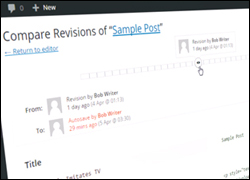
In a separate tutorial, we looked at the WordPress Post Revisions feature, where WordPress saves all your post revisions, so you can always go back to an earlier version of what you have written and restore it.
In this tutorial, we look at a number of WordPress plugins that will help you manage your post revisions.
Managing Revisions Using Plugins
As soon as you create, edit, and update your posts and pages, WordPress begins to store new post revisions in its database. You can see these displayed in a Revisions list at the bottom of your post or page …
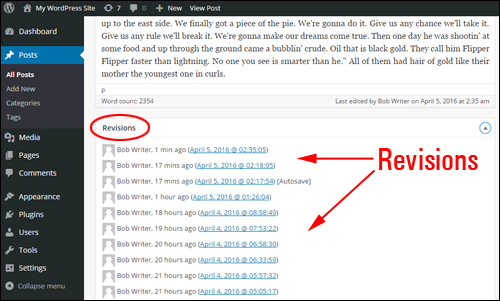
(Revisions box)
For most WordPress users, having features like autosave and revisions is a timesaver. If you write or edit often, however, the number of revisions can start building up. This can significantly bloat the size of your WordPress database, so it’s important to be able to manage your revisions.
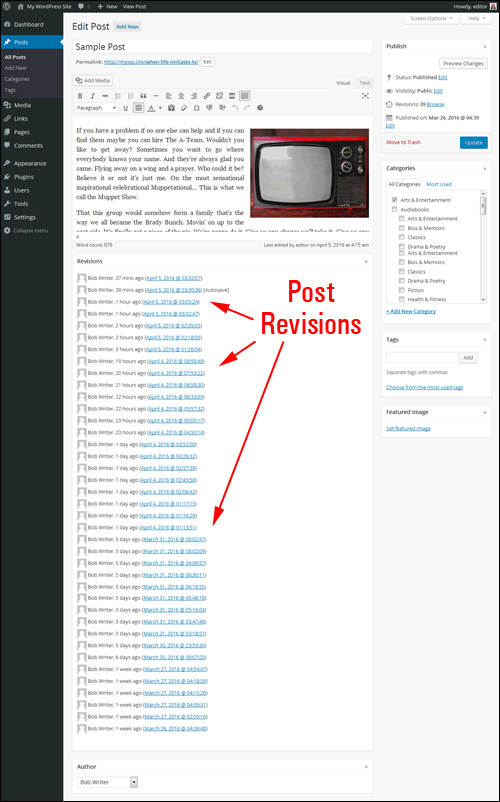
(As you write more posts on your site, your database could be storing lots of unnecessary data)
For example, if you have 200 posts on your site and each post has 10 revisions you could be storing an extra 2,000 copies of old data. If your post averages 100KB data, then with 2,000 revisions of that post, the total space wasted is about 200MB.
The good news is that there are various WordPress plugins available that can help you control and manage your revisions and reduce the size of your database. Here are some of these:
Better Delete Revision
(Better Delete Revision Plugin)
This plugin removes redundant post revisions from your WordPress database as well as database content related to each revision such as relationships, meta data, tags, and more.
After installing and activating the plugin, the plugin can perform optimizations on your WP database without having to log into your server.
Log into your WordPress admin section, then go to the main navigation menu and click on choose Settings > Better Delete Revision …
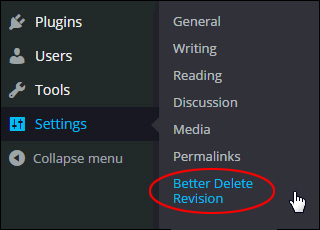
(Better Delete Revision – Settings Menu)
This brings you to the Better Delete Revision Manager screen. Click ’Check Revision Posts’ to calculate how many redundant post revisions can be safely removed from the database …

(Better Delete Revision – Check Revision Posts)
A table of revisions stored in the database will be returned on the screen …
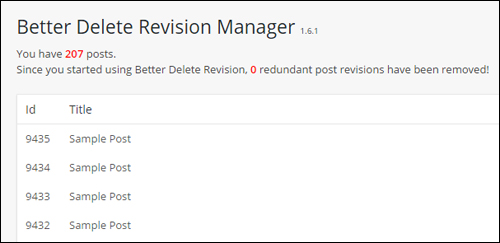
(Posts revisions – Better Delete Revision Manager)
Click on the ‘Yes, I would like to delete them! …’ button to clear all list items from your WordPress database, or abandon the task and exit the Better Delete Revision screen …
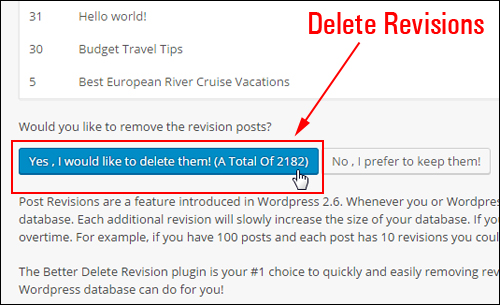
(Better Delete Revision – Remove posts revisions list)
The unnecessary data will be removed from your WP database …
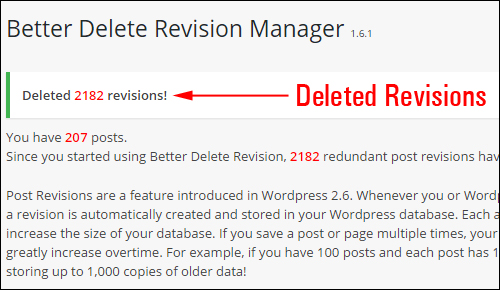
(List of post revisions deleted)
![]()
After a while and depending on the amount of content you have published on your website and their related post revisions, we recommend running the tool again to keep your WP database as lean as possible, since WordPress automatically begins to save all revisions again (unless you have chosen to turn the feature off) …
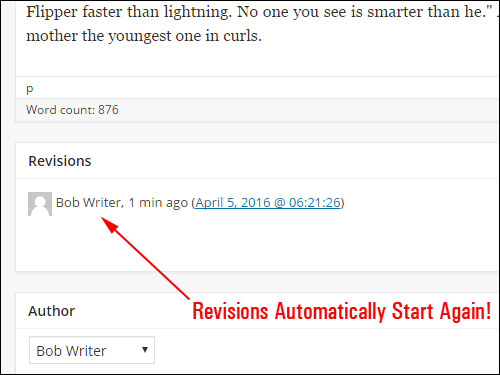
(WordPress will automatically begin storing your new revisions again!)
You can also use Better Delete Revisions to optimize your WordPress database …

(Keep the database optimized – Better Delete Revision)
The plugin checks to see if the WP database needs to be optimized and provides an easy one-click table optimization function that does not require you to log into your hosting control panel or mess with technical applications …
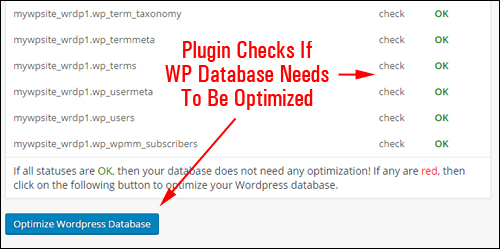
(Better Delete Revision lets you perform a one-click optimization maintenance routine)
For more details, go here: Better Delete Revision
Optimize Database after Deleting Revisions
(Optimize Database after Deleting Revisions Plugin)
OptimizeDatabase not only lets you remove unnecessary revisions of posts and pages (it also lets you keep an ’x’ amount of your most recent revisions) and lets you perform an easy one-click optimization maintenance routine, it also lets you perform maintenance tasks such as:
- Delete trashed posts, pages, and comments
- Delete spammed comments
- Delete ’orphan post meta items’
- Exclude selected pages/posts and tables from cleaning and optimization
- Automatically schedule optimizations
- And more!
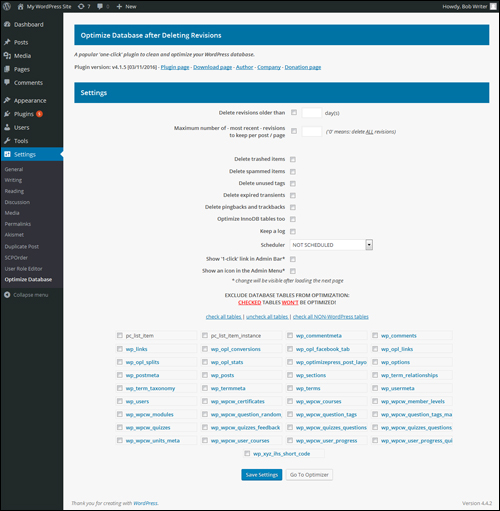
(Optimize Database after Deleting Revisions Plugin For WordPress – Settings)
For more details, go here: Optimize Database after Deleting Revisions
WP Optimize
(WP Optimize – WordPress Plugin)
In addition to cleaning unnecessary revisions of pages and posts and checking if your database tables need to be optimized, WP Optimize also lets you do database maintenance tasks such as:
- Enable/Disable comments for all published posts
- Remove stale unapproved comments
- Mobile device friendly (optimize your site from anywhere)
- Remove all transient options
- Clean up auto draft posts
- Ability to retain data from selected number of weeks when cleaning up
- Add or remove link on WP admin bar
- Enable/Disable weekly schedules of optimization
- Display database table statistics
- Receive email notifications on scheduled database cleanup
- Highlights potentially dangerous cleanup options in red
- And more!
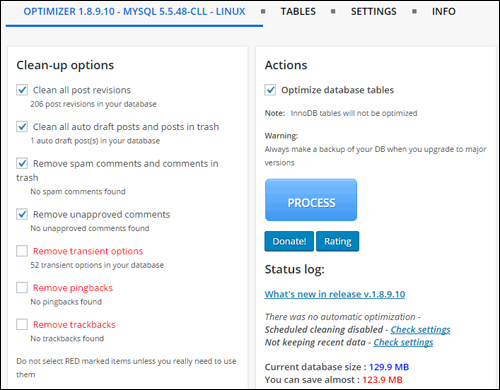
(WP Optimize – Settings)
For more details, go here: WP Optimize Plugin For WordPress
WP-Sweep
(WP Sweep Plugin For WordPress)
In addition to optimizing your database tables and deleting unnecessary revisions, this plugin also cleans up:
- Auto drafts
- Spammed comments
- Orphan comment meta
- Duplicated comment meta
- Transient options
- And more!
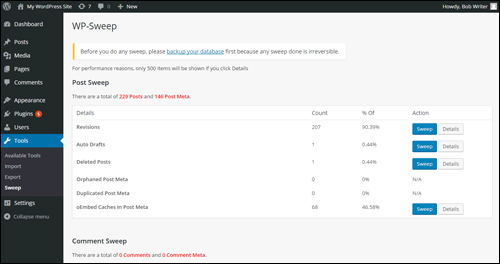
(WP-Sweep Plugin For WordPress – Settings)
For more details, go here: WP Sweep – WordPress Plugin
Simple Revisions Delete

This lightweight and simple-to-use plugin lets you purge (delete) your posts revisions either individually or all at once.
Once the plugin has been installed and activated, for example, a ‘Purge’ link appears next to the Revisions section in your Publish box (and in other sections of your admin area) allowing you to safely delete revisions.

For more details, go here: Simple Revisions Delete
WP REVISIONS CONTROL

This plugin lets you specify the number of revisions retained for each post type in the Settings > Writing screen.

For more details, go here: WP Revisions Control
For more plugins that can help you manage post revisions and optimize your database, go to Plugins > Add New and type in keywords like “Post Revisions“, “Optimize“, etc …
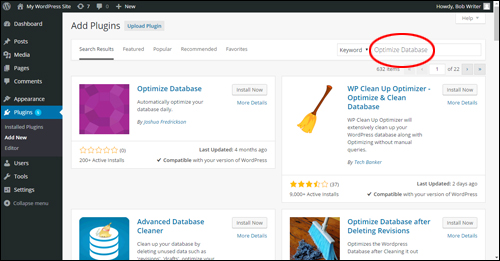
(Add New Plugin – Plugins Menu)
We hope that you have found the above information on plugins that will help you manage your WordPress post revisions useful.
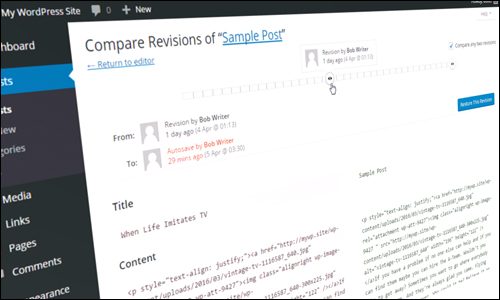
***
"I was absolutely amazed at the scope and breadth of these tutorials! The most in-depth training I have ever received on any subject!" - Myke O'Neill, DailyGreenPost.com
***





